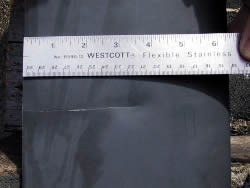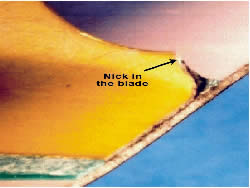Main-rotor blade failure
Helifor Industries Ltd.
MD Helicopters 369D C-GHFL
Eclipse Camp, Port Hardy, British Columbia
The Transportation Safety Board of Canada (TSB) investigated this occurrence for the purpose of advancing transportation safety. It is not the function of the Board to assign fault or determine civil or criminal liability. This report is not created for use in the context of legal, disciplinary or other proceedings. See Ownership and use of content. Masculine pronouns and position titles may be used to signify all genders to comply with the Canadian Transportation Accident Investigation and Safety Board Act (S.C. 1989, c. 3).
Summary
During flight, the pilot of the MD Helicopters 369D, serial number 1143D, registration C-GHFL, experienced a vibration and noticed that the main-rotor blades were slightly out of track. When this condition deteriorated such that one of the five blades appeared to be about six inches out of track, the pilot landed the helicopter.
Factual information
The helicopter was normally positioned on the deck of a floating barge, where it is subjected to weather. The weather on the days before the occurrence, at the operator's Eclipse Camp near Port Hardy, British Columbia, was reported as very windy. A 300-hour inspection was performed two days before the occurrence, and no anomalies were detected. The day before the occurrence flight, the main-rotor blades were removed to prevent damage from blade flapping because of very high winds. The blades were re-installed on the day of the occurrence; however, the winds were still high, so the blades were tied down when the helicopter was parked.
After the occurrence, company maintenance personnel inspected the blades and found that one of the five blades - part number 369D21100-523, serial number 009999-K077, the blade colour-coded yellow - had cracked at the upper and lower skins, from the trailing edge to the spar.
The subject main-rotor blade had accumulated 1988 hours between 22 April 1998 and 12 December 2000 while installed on another MD Helicopters 369D, C-GTZR. Torque eventsFootnote 1 were not recorded accurately; but beginning 25 July 1999, the operator started tracking torque events as accurately as possible. Tracking torque events requires a standardized system of recording. Some operators have reported as many as 40 torque events per hour. After service on C-GTZR, the blade was installed on the occurrence helicopter.On 26 March 2001, the failed blade was removed after accumulating a total time since new of 2266.3 hours. It is estimated that this blade had had 32 523 torque events.
The failed blade was examined visually and using X-rays, photography, scanning electron microscope, and optical microscope. The examination revealed a fatigue failure and crack that started from a nick or rough radius on the edge of a lightening hole on the C-channel structure of the blade, about three inches inboard of the data plate. The fracture propagated to the top and bottom skins of the blade and subsequently across the cord of the blade, causing a separation at the trailing edge. The fractures stopped at or near the 'D' spar structure near the leading edge of the blade.
McDonnell Douglas Helicopter Systems (MDHS, now known as MD Helicopters Inc. [MDHI]) issued Service Letter SL369D-111, dated 11 January 1999, to establish a new approach to tracking certain retirement lives of various helicopter components. Components such as the main-rotor blades were to be assigned retirement lives based on flight spectrums - flight test, fatigue test, and field experience. Some operators had reported exceeding the estimated average amount of high-stress manoeuvres in the flight spectrum, causing MDHS to re-evaluate the method of establishing limited lives, which only considered time in service. It was proposed that torque events be considered in the flight spectrum equation. Subsequently, on 15 May 2001, MDHI issued Service Bulletin SB369D-201, annotated as mandatory compliance. On 24 July 2001, MDHI issued Service Bulletin SB369D-201R1. These bulletins contain criteria to assist operators in understanding the level of usage, the impact of that usage on the main-rotor blade life, and the corresponding inspections required to find cracks that might occur. Compliance with service letters and bulletins is not mandatory under Transport Canada rules.
MDHI publishes airworthiness limitations that essentially establish life limits for helicopter components. In accordance with the MD Helicopters, Inc. Maintenance Manual, chapter 4, revision 29, the life limit for the subject blade, part number 369D21100-523, is 4000 hours in service. The blades have a scheduled inspection interval of 100 hours. After a blade has accumulated 750 flight hours and 13 720 torque events, operators are required to perform a main-rotor blade torque-event inspection every 35 flight hours or 200 torque events, whichever occurs first. No finite torque event number is established for the main rotor blades.
During the investigation, MDHI studied 28 blades for cracks or other damage. An examination of the C-channel was added to the study protocol. Four of the 28 blades showed cracking in the C-channel. Three of the four came from one aircraft involved in operations with a very high number of torque events per hour. The fourth was used in a manner that, although approved for the blade's operations, was outside the normal rotorcraft flight manual limits. The C-channel cracks observed in this study did not appear to be from any manufacturing defect. Blades exposed to a high number of torque events per hour were more likely to display cracks. The study showed that the cracked C-channel found in the Helifor blade was rare but not unique. It also showed that if a crack were present, its progression would be discovered very early with the implementation of Service Bulletin SB369D-201R1.
Analysis
A nick or inclusion, in the radius of a lightening hole on the C-channel, was introduced at manufacture and compromised the structural integrity of the main rotor blade. This nick caused a stress riser and was the origin of a crack that propagated to the blade's lower skin, trailing edge, and onto the top skin perpendicular to the span of the blade, where the crack stopped near the blade spar. A recent inspection of the blade by company maintenance failed to detect any damage or crack; this suggests that crack propagation may develop rapidly and be difficult to detect.
The blades were subjected to a variety of operations and a varying number of torque events that likely exceeded the estimated average number of high-stress manoeuvres in the flight spectrum determined by MDHI. Large differences in the count of torque events are likely because the type of operations affects the number of torque events and the recording of this number relies on pilots keeping an accurate count. Hence, MDHI rotor blades are subjected to a "fatigue factor" that may not be accurately tracked by operators.
Findings
Findings as to causes and contributing factors
- The main-rotor blade failed because its structural integrity was compromised by a manufacturing defect at the edge of a lightening hole in the C-channel, internal to the blade, located about three inches inboard of the data plate.
- The defect at the lightening hole resulted in a fatigue crack that propagated to the lower skin, rearward to the trailing edge, and around to the top skin going forward in the direction of the blade spar.
Findings as to risk
- The type of operation widely affects the number of torque events, and the recording of this number relies on the pilot keeping an accurate count. Differences in this count are likely; hence, component fatigue is not accurately tracked.
- Compliance with service letters and service bulletins issued by the manufacturer is not mandatory. Therefore, some operators may not be accurately tracking the torque events encountered by the helicopter blades.
- The periodicity for the inspection of the main rotor blades may be inadequate and insufficient to find cracks that might occur before catastrophic failure. No finite torque event number is established for the main rotor blades.
Safety action
The US Federal Aviation Authority is working on a notice of proposed rulemaking to expedite an airworthiness directive to effect mandatory compliance with MD Helicopters Inc.'s (MDHI) Service Bulletin SB369D-201R1 and Torque Events Inspection/Assessment.
Transport Canada noted that compliance with publications recommending the incorporation of modifications, the performance of inspections, or times between overhaul, are optional. However, aircraft owners have a duty to be aware of the contents of these publications and to evaluate the need for compliance in light of their own circumstances. Commercial operators should have a formalized process for conducting this evaluation as part of the evaluation program required by Canadian Aviation Regulation 706. Notice of Proposed Amendments (NPAs) 2002-249 and 2002-250, which the Canadian Aviation Advisory Council (CARAC) has approved, will be published in the near future. These NPAs amend CAR Part VI, making operators' responsibilities in this matter clear.
Transport Canada will continue to monitor this investigation and is considering taking unilateral action through an airworthiness directive, should the Federal Aviation Authority not mandate MDHI Mandatory Service Bulletin SB369D-201R1.
MDHI no longer manufactures main-rotor blades for 500-series helicopters. Under parts manufacturing approval, Helicopter Technologies Corporation (HTC) now assures the supply of these blades. HTC has incorporated an ultrasonic inspection as part of its manufacturing process to check for subsurface defects, voids, and cracks that, if undetected, may affect the structural integrity of the blades.
This report concludes the Transportation Safety Board's investigation into this occurrence. Consequently, the Board authorized the release of this report on .

